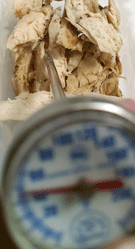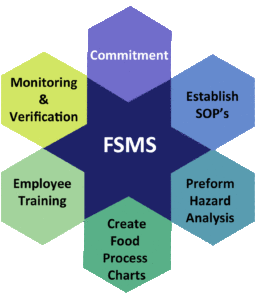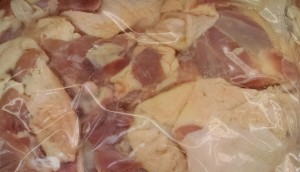Monitoring refrigeration units.
Have you ever had a unit break down in the middle of the day? How about a unit that just can’t seem to maintain food temperatures below 41°F?
Both present potential risks to food safety. Proper monitoring of your units can avoid the costly choice of throwing food away that has become unsafe.
What is required by Code of Maryland Regulations (COMAR)? Section 10.15.03.06 pertains to storage, service and transport of foods in retail establishments in Maryland. Today we will focus on monitoring cold food storage only.
The internal temperature of the food must be maintained to avoid pathogenic bacteria and other microorganisms that could cause spoilage. Most food must be held at 41°F or below except; shell eggs can be stored at 45°F or less, certain reduced oxygen packaged foods like crab meat should be stored at 38°F or less.
The temperature measuring device has 2°F markings, accurate within +- 2°F, calibrated at least annually, is easily readable, and located in the warmest area of unit where food is stored.
Anytime Temperature Control for Safety (TCS) foods or as COMAR calls them, Potentially Hazardous Food (PHF) goes above the required temperature for more than 4 hours the product must be discarded.
This is a summary of the regulations, for complete information read the regulation.
How often are you required to monitor foods?
Surprisingly, there is no regulation that states how often you must monitor foods. You do need to make sure temperatures are maintained. So that would infer that you should monitor every 4 hours so you can take the corrective action of throwing the food away.
How often do I recommend you monitor food temperatures?
I recommend that you monitor and record your refrigeration and cooler temperatures every 2 hours. This will provide you with a verifiable temperature that can be used in case the unit experiences a problem. The following are two similar examples with different outcomes
Example 1: You monitored the temperature at 12 PM and at 4 PM you discovered the product temperature to be at 57°F. The only corrective action you can take is to discard the food.
Example 2: You monitored and recorded the temperature at 12 PM and then again at 2 PM. At that time you discover the food temperature to be at 52°F. You could move the food to another unit, perhaps a freezer and quick chill the product. Check the temperature again at 4 PM to verify it is at 41°F or below. If it is, you just saved your inventory! The reason is because you had a verifiable temperature at 12 PM and could verify the food was not out of temperature for more than 4 hours.
Important to remember in example 2 is that the temperature was verifiable. Had it not been recorded you would have needed to discard the food. The code specifically states that food must be discarded if “The food has exceeded 41°F or more for more than 4 hours; or the time the food has been out of temperature is not verifiable”
How should you monitor temperatures?
You could take the internal temperature of each food in your unit but that would be time consuming and possibly increase the risk of cross contamination. Monitoring is typically accomplished by having a thermometer in the warmest part of the unit. I do not recommend using the digital readout on the outside of the unit. If you notice the lead is typically in one of the coldest parts of the unit, not the warmest. Try this experiment. During peak times check what the reader says and then check the internal thermometer and the internal temperature of the food. Most of the times there will be a difference in these temperatures. In my experience sometimes 7°F or more.
Remember the thermometer used for monitoring needs to be accurate +-2°F and have markings every 2°. COMAR requires it be calibrated at least annually however, if it is dropped or undergoes any kind of abuse it should be checked for accuracy. One simple way to check the stand-up or hanging type is place several in the same unit and make sure they are all the same. Confirm temperature by checking the internal temperature of food that has been in the unit. It should be with in a degree or two.
If you have any questions about monitoring your temperatures and corrective actions please contact us, we are here to help.

 How often do you check your cold hold and hot hold temperatures?
How often do you check your cold hold and hot hold temperatures?
 Raw sewage is flowing into our streams and rivers and eventually to the Chesapeake Bay. Where is this sewage coming from? A key source is an antiquated storm water and sewage system for Baltimore City. In 2002 the Maryland Department of the Environment (MDE) sued Baltimore City and an original consent degree to correct overflow of raw sewage was filed. There was a 2016 deadline for Baltimore City to correct existing problems. Although some progress was made, the deadline passed and there were still sever deficiencies. A modified decree was approved October 6, 2017 that extended the time allowed to correct problems. It is broken down in two Phases. First phase must be completed by 2021 and second phase by 2030.
Raw sewage is flowing into our streams and rivers and eventually to the Chesapeake Bay. Where is this sewage coming from? A key source is an antiquated storm water and sewage system for Baltimore City. In 2002 the Maryland Department of the Environment (MDE) sued Baltimore City and an original consent degree to correct overflow of raw sewage was filed. There was a 2016 deadline for Baltimore City to correct existing problems. Although some progress was made, the deadline passed and there were still sever deficiencies. A modified decree was approved October 6, 2017 that extended the time allowed to correct problems. It is broken down in two Phases. First phase must be completed by 2021 and second phase by 2030.
